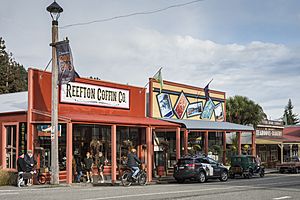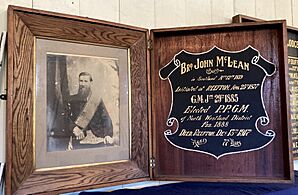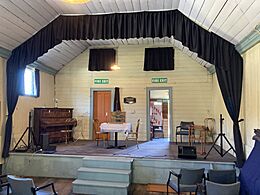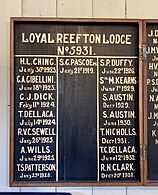Reefton facts for kids
Quick facts for kids
Reefton
|
|
|---|---|

Broadway
|
|
| Country | New Zealand |
| Region | West Coast |
| District | Buller District |
| Ward | Inangahua Ward |
| Community | Inangahua Community |
| Electorates |
|
| Area | |
| • Total | 2.63 km2 (1.02 sq mi) |
| Population
(June 2023)
|
|
| • Total | 910 |
| • Density | 346.0/km2 (896/sq mi) |
Reefton is a small town in the West Coast region of New Zealand. It's about 80 kilometers northeast of Greymouth. The town sits in the Inangahua River valley.
Reefton is famous for being the first town in New Zealand to have electric street lights. This happened in 1888. The electricity came from the Reefton Power Station. In the late 1800s, Reefton was a busy gold mining town. Gold mining took place here from the 1870s to the 1950s. Today, Reefton's economy relies on tourism, forestry, coal mining, and farming. The town is also home to the Inangahua County Library.
Contents
What's in a Name?
Reefton got its name from the rich gold found in a quartz reef nearby. It was first called "Reef Town." People also used nicknames like "Rest Town" and "Quartzopolis." The main street, Broadway, was named after Charles Broad, a local judge. A mine called "Wealth of Nations" was named after a famous book by Adam Smith. This was because another Adam Smith (no relation!) found gold there.
Reefton's Past
Reefton has a rich history, especially with gold and new technologies. Here are some key dates:
- 1866 – Gold was found in the Īnangahua Valley. This was "alluvial gold," meaning it was found in riverbeds.
- 1870 – Gold was discovered in quartz reefs at Reefton. This meant digging into rock to find it.
- 1872 – Reefton Hospital opened.
- 1886 – Reefton School of Mines opened. This school taught people how to mine using scientific methods.
- 1888 – The town started getting electricity.
- 1892 – The railway line opened, connecting Reefton to other places.
- 1908 – The rail line was extended to Cronadun.
- 1912 – Mine workers had a "lock-out," a disagreement with mine owners.
- 1967 – Passenger train services stopped.
Gold Mining in Reefton
The first gold was found near Reefton in 1866. But the big discovery of gold in quartz reefs happened in 1870. By 1872, people were already taking gold out of the ground. Reefton and Lyell were the only places in the area where gold was mined from quartz reefs.
An older settlement called Ross Town was on the other side of the Inangahua River. But in 1871, most businesses moved to Reefton. This was to be closer to the quartz mining. There were also mines in nearby places like Waiuta and Blacks Point.
In the 1880s, gold mining slowed down. This was because there wasn't enough money to dig deeper mines. In 1896, a company called Consolidated Goldfields New Zealand was formed. They ran several mines and updated the technology. The Reefton School of Mines helped miners use better scientific methods.
The Blackwater mine worked from 1908 until 1951, when a tunnel collapsed. It reopened in 2020 as the Snowy River mine. By 2024, workers had dug 9 kilometers of tunnels. The Globe Progress mine was an opencast (open-air) mine. It produced a lot of gold from 2007 to 2016.
How Reefton Got Electricity
In 1888, Reefton became the first town in New Zealand to have electricity. Walter Prince made this happen. The streets were lit by commercial electricity from the Reefton Power Station. The power station was taken down in 1961. But a group called the Reefton Power House Charitable Trust is working to rebuild it. They started work in 2019.
Reefton's Location and Weather
Reefton is in the Inangahua Valley, about 194 meters above sea level. It has an oceanic climate, which means it's usually mild. However, because it's inland, Reefton can have more extreme temperatures. It has recorded both the highest temperature (33.7 °C) and the lowest temperature (-8.5 °C) in the West Coast region.
February is the warmest month, with an average temperature of 17.4 °C. July is the coldest, at 5.4 °C. The average yearly temperature in Reefton is 11.7 °C. Summer afternoons are often warmer here than in coastal towns like Greymouth. Winter mornings can be much colder. This is because of the local hills, which trap cold air at night. Reefton usually has 24 days a year over 25 °C. In winter, it can have 46 days of air frost and 61 days of ground frost.
Reefton is also the driest area on the West Coast. This is because the Paparoa Range mountains block some of the rain.
| Climate data for Reefton (1991–2020 normals, extremes 1960–present) | |||||||||||||
|---|---|---|---|---|---|---|---|---|---|---|---|---|---|
| Month | Jan | Feb | Mar | Apr | May | Jun | Jul | Aug | Sep | Oct | Nov | Dec | Year |
| Record high °C (°F) | 33.7 (92.7) |
33.5 (92.3) |
30.1 (86.2) |
25.6 (78.1) |
22.1 (71.8) |
19.0 (66.2) |
18.9 (66.0) |
19.4 (66.9) |
24.8 (76.6) |
26.2 (79.2) |
30.9 (87.6) |
32.2 (90.0) |
33.7 (92.7) |
| Mean daily maximum °C (°F) | 23.4 (74.1) |
23.6 (74.5) |
21.2 (70.2) |
17.4 (63.3) |
13.7 (56.7) |
10.5 (50.9) |
10.2 (50.4) |
12.4 (54.3) |
14.9 (58.8) |
16.7 (62.1) |
19.0 (66.2) |
21.5 (70.7) |
17.0 (62.7) |
| Daily mean °C (°F) | 17.3 (63.1) |
17.4 (63.3) |
15.2 (59.4) |
12.1 (53.8) |
9.1 (48.4) |
6.2 (43.2) |
5.4 (41.7) |
7.4 (45.3) |
9.6 (49.3) |
11.4 (52.5) |
13.4 (56.1) |
15.9 (60.6) |
11.7 (53.1) |
| Mean daily minimum °C (°F) | 11.2 (52.2) |
11.2 (52.2) |
9.2 (48.6) |
6.9 (44.4) |
4.5 (40.1) |
2.0 (35.6) |
0.7 (33.3) |
2.3 (36.1) |
4.3 (39.7) |
6.1 (43.0) |
7.8 (46.0) |
10.3 (50.5) |
6.4 (43.5) |
| Record low °C (°F) | 0.7 (33.3) |
0.5 (32.9) |
−0.5 (31.1) |
−3.5 (25.7) |
−6.1 (21.0) |
−8.0 (17.6) |
−8.5 (16.7) |
−7.0 (19.4) |
−5.0 (23.0) |
−3.9 (25.0) |
−3.0 (26.6) |
−0.1 (31.8) |
−8.5 (16.7) |
| Average rainfall mm (inches) | 138.6 (5.46) |
101.8 (4.01) |
108.6 (4.28) |
143.0 (5.63) |
170.8 (6.72) |
189.7 (7.47) |
161.8 (6.37) |
179.1 (7.05) |
176.6 (6.95) |
182.1 (7.17) |
149.7 (5.89) |
162.4 (6.39) |
1,864.2 (73.39) |
| Mean monthly sunshine hours | 223.3 | 195.1 | 174.9 | 129.4 | 89.6 | 70.7 | 90.8 | 113.8 | 147.6 | 157.2 | 197.9 | 204.9 | 1,795.2 |
| Source: NIWA | |||||||||||||
Reefton's People
Reefton covers 2.63 square kilometers. In 2023, about 910 people lived there.
| Population of Reefton | ||
|---|---|---|
| Year | Pop. | ±% p.a. |
| 1996 | 1,044 | — |
| 2001 | 987 | −1.12% |
| 2006 | 981 | −0.12% |
| 2013 | 1,056 | +1.06% |
| 2018 | 927 | −2.57% |
| Population counts from the New Zealand census. Populations before 2006 may use slightly different boundaries. | ||
At the 2018 census, Reefton had 927 people. There were 447 households. The town had slightly more males than females. The average age was 51.9 years, which is older than the national average. About 14% of the people were under 15 years old.
Most people in Reefton (90%) are European/Pākehā. Some people also identify as Māori (13.3%), Pasifika (1.0%), or Asian (2.9%).
Many people in Reefton (53.1%) said they had no religion. About 32% were Christian.
Reefton's Economy
Gold mining started again in 2007 when Oceana Gold opened a new mine. This mine employed 260 people in 2013. It closed in 2016, and the company worked to restore the land.
A new gold mine is expected to open in 2024. It plans to hire 100 people. Other important industries in Reefton are coal mining, forestry, and tourism. The town also provides services for the farming industry.
Getting Around Reefton
Reefton is located where two main roads meet: State Highway 7 and State Highway 69.
Rail Travel
Reefton is on the Stillwater–Westport Line railway. This line connects to the Midland Line in Stillwater. The railway reached Reefton in 1892. At first, it stopped on the other side of the Inangahua River. Later, a bridge was built, and the current station was set up in Reefton.
The line was extended beyond Reefton to Cronadun in 1908. By 1943, the line officially connected all the way to Westport. Passenger train services through Reefton stopped in 1967. Today, the railway mainly carries coal. Many coal trains run through Reefton every day.
Learning in Reefton
The first state school in Reefton opened in 1878. There used to be 24 schools in the area!
Reefton Area School teaches students from Year 1 to Year 13. It was formed in 2004 by combining Reefton School and Inangahua College. Sacred Heart School is a Catholic primary school for Years 1 to 8. Both schools are for both boys and girls.
Media in Reefton
Reefton used to have several newspapers. The Inangahua Herald and New Zealand Miner started in 1872. It was published several times a week, then daily. Its main competitor was the Inangahua Times, which started in 1875. For a short time, Reefton, a small town, had three daily newspapers!
During the Great Depression, the Herald merged with the Times in 1936. The Times stopped publishing in 1942 because of war shortages. It was brought back in 1946 as the Inangahua-Murchison Times, but it stopped in 1956.
Today, people in Reefton can listen to local radio stations like The Hits and Coast FM. The Greymouth Star newspaper is also delivered daily.
Famous People from Reefton
- Marty Banks – a rugby union player who grew up in Reefton.
- Amy Castle – a museum curator and expert on insects, born in Reefton.
- Myra Cohen – known for being a barber, dental assistant, and entertainer.
- Elisabeth Croll – an anthropologist, born in Reefton.
- Phill Jones – a basketball player who grew up in Reefton.
- Melanie Nolan – a historian who studies work and gender, born in Reefton.
- Edward Smyrk – a cricketer, born in Reefton.
Images for kids
- Reefton Oddfellows Hall















